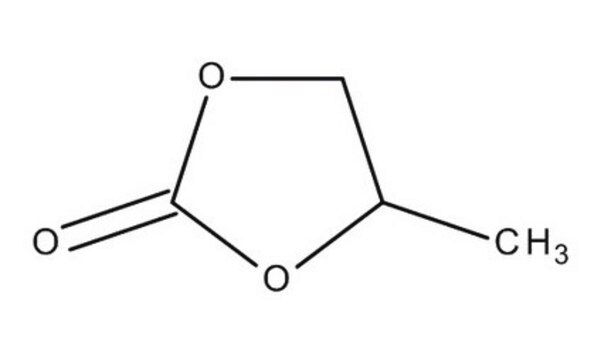PX1286B
Poli(etilenglicol)
400
Sinónimos:
PEG
About This Item
Productos recomendados
vapor pressure
<0.1 hPa ( 20 °C)
Quality Level
form
liquid
color
APHA: ≤18
pH
5-7 (20 °C, 100 g/L in H2O, neutral)
mp
5 °C
transition temp
flash point >200 °C
shipped in
ambient
storage temp.
room temp
SMILES string
C(CO)O
InChI
1S/C2H6O2/c3-1-2-4/h3-4H,1-2H2
InChI key
LYCAIKOWRPUZTN-UHFFFAOYSA-N
¿Está buscando productos similares? Visita Guía de comparación de productos
Application
- Flexible Hydrogelation for Tactile Sensing: Recent research highlights the application of polyethylene glycol in bioinspired flexible hydrogels with programmable properties, enhancing the capabilities for tactile sensing applications (Wang et al., 2024).
- Ocular Drug Delivery: Polyethylene glycol has been utilized in a sterilizable platform based on crosslinked xanthan gum for the controlled release of polymeric micelles, aimed at delivering neuroprotective compounds to the posterior eye segment (Signorini et al., 2024).
- Nanoscale Drug Delivery Systems: A study on the nanoscale evaluation of black phosphorus nanosheets functionalized with polyethylene glycol and drug-loaded gold nanoparticles emphasizes its potential in enhancing drug delivery system stability (Gunathilaka and Shimomura, 2024).
- Amphiphilic Thermogels for Biomedical Use: Polyethylene glycol is a key component in the design of carbosilane dendritic networks for developing high-swelling amphiphilic thermogels, suitable for various biomedical applications (Muñoz-Sánchez et al., 2024).
- Biomedical and Environmental Polymer Applications: The role of polyethylene glycol in synthesizing natural and synthetic polymers showcases its versatility in both biomedical and environmental applications, offering new opportunities for sustainable material development (Satchanska et al., 2024).
Analysis Note
Storage Class
10 - Combustible liquids
wgk_germany
WGK 1
flash_point_f
281.5 °F - closed cup
flash_point_c
138.6 °C - closed cup
Certificados de análisis (COA)
Busque Certificados de análisis (COA) introduciendo el número de lote del producto. Los números de lote se encuentran en la etiqueta del producto después de las palabras «Lot» o «Batch»
¿Ya tiene este producto?
Encuentre la documentación para los productos que ha comprado recientemente en la Biblioteca de documentos.
Los clientes también vieron
Nuestro equipo de científicos tiene experiencia en todas las áreas de investigación: Ciencias de la vida, Ciencia de los materiales, Síntesis química, Cromatografía, Analítica y muchas otras.
Póngase en contacto con el Servicio técnico

